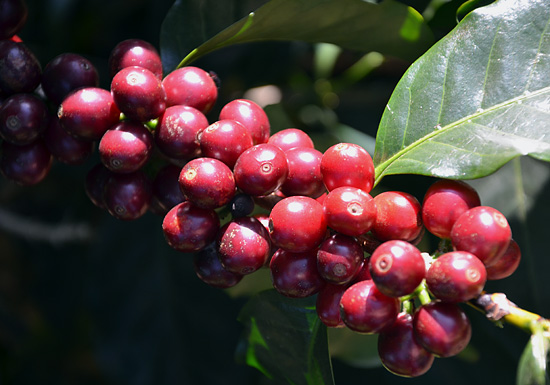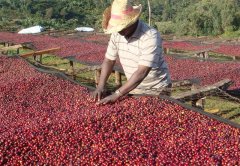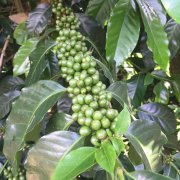Costa Rica 2016 COE third Runner-up Brumas processing Plant Centro Manor Verassa Singularity Red

For professional baristas, please follow the coffee workshop (Wechat official account cafe_style)
Product name: Costa Rica 2016 third runner-up Brumas processing plant Centro Manor Verassa strange red honey
(Costa Rica Brumas del Zurqui El Centro Villa Sarchi Red Honey)
Flavor description: Gaoshan pear, ripe orange fruit, floral notes,
Baked walnut, elegant sour but lively, black sugar finish.
Finca El Centro won 19th place in the 2017 Costa Rican Excellence Cup (COE)
Third place in the 2016 Costa Rican Excellence Cup (COE)
And 6th place in the 2015 Costa Rican Excellence Cup (COE)
Production of award-winning manor records through Brumas processing plant:
19th Centro Manor (Finca El Centro) in the Costa Rican Excellence Cup (COE) in 2017
20th place in the 2017 Costa Rican Excellence Cup (COE) (Finca El Beneficio)
2017 Costa Rico Cup (COE) 28th (Finca Do ñ a Clemencia)
Centro Manor (Finca El Centro), 3rd place in the 2016 Costa Rican Excellence Cup (COE)
Centro Manor (Finca El Centro), 6th place in the 2015 Costa Rican Excellence Cup (COE)
Second place in the 2015 Costa Rican Excellence Cup (COE) (Finca El Beneficio)
18th place in 2014 Costa Rican Excellence Cup (COE) Competition (La Nena)
Seventh place in the 2013 Costa Rican Excellence Cup (COE) Competition (La Nena)
12th place in 2013 Costa Rica Excellence Cup (COE) Competition (Zamora)
The first place in the 2012 Costa Rican Excellence Cup (COE) Competition (Zamora)
2012 Costa Rica Excellence Cup League tournament
(1st place in Excellence for Coffee A (93.47 points in cup test)
2012 Costa Rica Agricultural Poultry and Coffee Association Department (the Ministry of Agriculture
And Livestock and the Coffee Institute of Costa Rica)
Award for Best Coffee improvement contribution Award
The second place in 2006 Costa Rica non-Coffee Management Promotion official Unit (SINTERCAFE) Cup Test Competition
Producing area: central valley (Central Valley)
Manor: Centro Manor (Finca El Centro)
Processing plant: Brumas processing plant (Beneficio Brumas del Zurqui)
Variety: Kaddura species (caturra)
Altitude: 1450 to 1600 m
Grade: European extremely hard beans SHB
Treatment: red honey treatment
Harvest time: November to March
Certification: NCMA
Introduction:
Costa Rica has a long history of cultivating coffee, but in the past 10 years, it has been treated by a new "dry" method.
It has become a new method, collectively known as "honey treatment", which uses the scraper to adjust the scraping degree of the pulp.
The output shows "honey" from light to strong with the color from light to dark (white, yellow-red-white, yellow-red-black), with acidity.
Complex aroma, thick feeling... Each has its own depth and advantages. Honey treatment started in Costa Rica.
At the same time, Costa Rica has also developed a micro-processing plant (micro mill) with the characteristics of coffee.
The main feature of the development is the hope that every small farm can have its own system for handling beans.
Can be collected from the processing is completed by the farm itself, can be treated according to their own unique process
Produce the best specialty coffee and raw beans. Blumas Manor (Finca Brumas del Zurqui)
There is a family-owned raw bean processing plant, which originally means "a valley full of clouds."
In addition to growing coffee, the manor also assists in the OEM of nearby estates and coffee farmers. Coffee has been growing since 1880
In 2006, Brumas won the champion of the Costa Rican National Coffee Competition, the "honey treatment" of the estate.
It was immediately paid attention to by bean merchants all over the world. So since 2007, Brumas' coffee beans have always been in the competition.
It was snapped up before.
Costa Rican coffee has always been regarded as the perfect type of classic flavor, balanced, clean and mild.
Is his tone, this micro-batch of Brumas Manor family processing plant and Centro Manor
(Finca El Centro) Red honey coffee produced by the Vera Saqi variety (Villa Sarchi) harvested.
Brumas Manor is the Juan Ramon Alvarado and Natalia Gomez family in 2004.
The establishment of a micro water treatment plant Brumas treatment Plant (Brumas del Zurqui), this family
Has been engaged in coffee cultivation and production for more than a century, especially Juan Ramon Alvarado is honey treatment
Coffee technology leader, in 2016 Costa Rico Cup (COE) won the third runner-up processing plant in 2015
Family member Natalia Gomez's estate El Beneficio is treated with honey through the Brumas processing plant.
Experience won the second place in the COE competition, which shows that his family manor and processing plant are by no means famous.
By chance. Juan Ramon Alvarado, he currently has two estates, one is Zamora and the other is La Nena.
Coffee varieties are bourbon, Kaddura (caturra), geisha and others.
This micro-batch of Centro Manor is treated with red honey through the Brumas processing plant.
Flavor description: Gaoshan pear, ripe orange fruit, floral notes, roasted walnut, elegant acidity but lively,
The remaining rhyme of black sugar.
Costa Rican coffee cultivation was introduced from Cuba in 1779 and exported for the first time in 1820.
There are about 32000 coffee farmers, with an average planting area of less than one hectare (10000 hectares) per farmer.
Costa Rica has a population of 41 billion (2006), with a coffee planting area of 82500 hectares and annual production.
1.7 million bags (60kgs per bag), with an annual domestic consumption of 380000 bags, with an average annual consumption of 5.5kgs per national
It is higher than Japan's (consumption of 4kgs), and the average Taiwanese are only slightly higher than 1kg.
Costa Rica is the country where coffee was first introduced into Central America. It has a long history and is self-produced by coffee organizations.
Until the sales system is complete. Because it is located in the Central American Gorge, there are many volcanoes in the territory, which has the natural advantages of sunshine and land.
The climate is reconciled by Pacific and Atlantic currents and sea breezes at the same time, and the coffee produced is local.
Due to the characteristics of micro-climate and local conditions, Costa Rican coffee has always been recognized by the world in terms of quality and quantity.
Rated as one of the world-class high-quality coffee. Costa Rican coffee has been grown for 200 years.
Originally planted on the slopes of Poas and Barva volcanoes, it is now known as the Central Valley (Central Valley).
The seven main coffee producing areas are from northwest to southeast, along with the inland central plateau.
The Costa Rican volcanic terrain has fertile volcanic ash, mild and suitable temperatures, and stable and abundant rainfall.
It is one of the reasons why coffee has become one of the main agricultural products in Colombia. The seven major producing areas are: Tarrzu,
Tres Rios 、 Orosi 、 Central Valley 、 West Valley 、 Turrialba 、 Brunca .
Important Notice :
前街咖啡 FrontStreet Coffee has moved to new addredd:
FrontStreet Coffee Address: 315,Donghua East Road,GuangZhou
Tel:020 38364473
- Prev

Introduction to the planting Environment of Black Honey Coffee in Rivas Manor, Costa Rica
Professional barista exchange please follow the coffee workshop (Wechat official account cafe_style) Product name: Costa Rica Torres Manor Black Honey Rivas people processing Plant (Costa Rica Brunca Finca Las Torres Catuai/Caturra Black Honey) Flavor description: caramel, honey, spices, frankincense myrrh, pepper, cherry chocolate, fat full and thick
- Next

Introduction to the Flavor and Flavor of Coffee treated by TABLON Kadu Aimi in Tophun Manor, Costa Rica
For the exchange of professional baristas, please follow the coffee workshop (official Wechat account cafe_style) Product name: TABLON Kaduai Honey treatment (Costa Rica Finca Tobosi TABLON Catuai Honey) Flavor description: soft aromas of fruit, flowers, almonds, vanilla, walnuts, mild sweetness, meticulous taste, smooth and full award winning taste
Related
- Detailed explanation of Jadeite planting Land in Panamanian Jadeite Manor introduction to the grading system of Jadeite competitive bidding, Red bid, Green bid and Rose Summer
- Story of Coffee planting in Brenka region of Costa Rica Stonehenge Manor anaerobic heavy honey treatment of flavor mouth
- What's on the barrel of Blue Mountain Coffee beans?
- Can American coffee also pull flowers? How to use hot American style to pull out a good-looking pattern?
- Can you make a cold extract with coffee beans? What is the right proportion for cold-extracted coffee formula?
- Indonesian PWN Gold Mandrine Coffee Origin Features Flavor How to Chong? Mandolin coffee is American.
- A brief introduction to the flavor characteristics of Brazilian yellow bourbon coffee beans
- What is the effect of different water quality on the flavor of cold-extracted coffee? What kind of water is best for brewing coffee?
- Why do you think of Rose Summer whenever you mention Panamanian coffee?
- Introduction to the characteristics of authentic blue mountain coffee bean producing areas? What is the CIB Coffee Authority in Jamaica?

